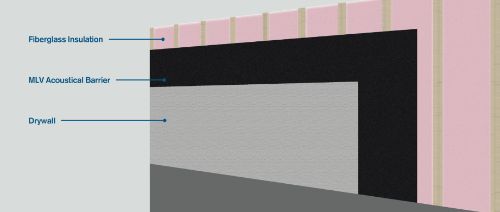FREE Standard Shipping
Free shipping is valid on any order shipped to a single address in the mainland USA. Standard shipping is covered. Overnight or 2-day delivery will cost extra and is not available on custom-made products.
Speak to an Expert: 1.800.679.8511
Free shipping on all USA orders
Free shipping is valid on any order shipped to a single address in the mainland USA. Standard shipping is covered. Overnight or 2-day delivery will cost extra and is not available on custom-made products.
Luxury Liner™ 1 lb Mass Loaded Vinyl Roll
Luxury Liner™ 1 lb Mass Loaded Vinyl is a premium sound barrier designed for use in buildings of all types. At just 1/8” thick, this flexible yet dense material adds significant mass to walls and ceilings, blocking airborne noise between rooms and adjacent spaces. From new homes and commercial facilities to home theaters and offices, it’s a simple, durable solution for reducing unwanted sound transmission. Safe, fire resistant, and long-lasting, Luxury Liner™ is trusted for both new construction and renovation projects.
Features
High-Performance Sound Barrier – Blocks airborne noise transfer between rooms with an STC rating of 27.
Specs
| Dimensions | 4’ x 10’, 4’ x 15’, 4’ x 25’, 4.5’ x 10’, 4.5’ x 20’, 4.5’ x 30’ |
| Thickness | Nominal 1/8" |
| Weight | 1 lb per sq ft, 2 lbs per sq ft |
| Color | Black |
| Temperature Rating | 175 °F |
| STC Rating | 27 |
Resources
| Spec Sheet | Luxury Liner Product Sheet |
| Architect CSI Spec | Luxury Liner MLV CSI Spec |
| Install Guide | Luxury Liner Install Guide |
Material Testing
Sound Transmission Loss
| Frequency (Hz) | 125 | 250 | 500 | 1000 | 2000 | 4000 | STC Rating |
| 1 lb MLV Sound Transmission Loss (dB) | 14 | 19 | 23 | 29 | 34 | 37 | 27 |
| 2 lb MLV Sound Transmission Loss (dB) | 19 | 20 | 27 | 34 | 38 | 43 | 32 |
| Tested Properties | Testing Method | Performance |
| Tensile Strength | ASTM D412 | Minimum 400 psi |
| Elongation | ASTM D412 | 120% |
| Tear lbs / 1" | ASTM D624 | 77 |
| Federal Motor Vehicle Safety Standard | FMVSS 302 | Pass |
Installation Instructions
Home & Commercial
Recommended Install Method: staples, screws, nails, or hung with reinforced grommets
Steps to Soundproof a Wall

Have a Smaller Project? You should take a look at a MLV sheet.
Our Quiet Quilt line of sound blankets combine reinforced MLV with a vinyl facing for sound absorption and sound blocking. We also can put MLV inside a fabric wrapped panel to create a soundproof panel. Contact us for details.
Common Product Uses
| Application | How It's Used |
|---|---|
| Rooms & Walls | Soundproof any room, interior walls, office partition walls, bathroom wall treatments |
| Machinery Enclosures | Line or wrap machinery enclosures to contain noise |
| Generator Enclosures | Build or line generator boxes and enclosures for quieter operation |
| Soundproof Boxes | Create custom soundproof boxes for noisy equipment |
| Pipes | Wrap noisy PVC or other pipes to reduce sound transmission |
| Ductwork | Wrap HVAC ducts to minimize noise through ventilation systems |
| Mechanical Spaces | Reduce noise in mechanical rooms and utility areas |
| Window Covers | Use as a temporary or supplemental window cover for noise reduction |